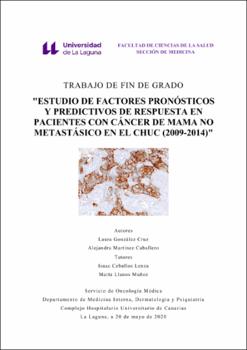Estudio de factores pronósticos y predictivos de respuesta en pacientes con cáncer de mama no metastásico en el CHUC (2009-2014)
Fecha
2020Resumen
Introducción y justificación. La QTNA es el tratamiento inicial del cáncer de mama en
estadios localmente avanzados. Se han descrito distintos factores predictivos de respuesta,
siendo la RPc la de mayor significación pronóstica por haber demostrado aumentar la SLE y
SG.
Material y métodos. Estudio observacional retrospectivo que incluye 120 pacientes que
recibieron QTNA en el CHUC durante 2009-2014. Posteriormente fueron operados para
evaluar la respuesta en mama y/o axila en busca de analizar el efecto que la QTNA había
supuesto para los distintos factores pronósticos.
Resultados. Alcanzó la RPc el 21,7%, que se observó en mayor proporción en tumores
pobremente diferenciados (30%), Ki-67 >50% (30,6%), estadios precoces (23,8%), esquemas
basados en antraciclinas y taxanos (23,4%), subtipos HER2 (36,2%, p<0,002) y triple negativo
(24,1%). El subtipo que más progresiones registró habiendo alcanzado la RPc fue el triple
negativo (28,6%).
Las pacientes que alcanzaron una RPc asocian mayores tasas de supervivencias a los 10 años
(p <0,023). El Ki-67 post QTNA >50% se asoció a menor SLE (p<0,001).
Conclusión. La respuesta a la QTNA fue heterogénea según los subtipos moleculares
(p<0,023). Los tumores HER2 positivo asociaron mayor relación de RPc (p<0,002) y las
mayores tasas de SLE y SG a los 10 años del diagnóstico. Alcanzar la RPc se traduce en
mayores proporciones de SG y SLE (p<0,002) en todos los subtipos, particularmente en
tumores RRHH positivo/HER2 negativo y HER2 positivo. Introduction and justification. QTNA is the initial treatment for locally advanced stages of
breast cancer. Different predictive factors of response have been described, with the RPc being
the one with the highest prognostic significance as it has been shown to increase SLE and SG.
Material and methods. Retrospective observational study that includes 120 patients who
received QTNA at the CHUC during 2009-2014. Subsequently, they were operated on to
evaluate the response in the breast and/or in the armpit in order to analyze the effect that the
QTNA had had for the different prognostic factors.
Results. cPR reached 21.7%, which was observed in a higher proportion in poorly
differentiated tumors (30%), Ki-67> 50% (30.6%), early stages (23.8%), anthracycline and
taxanes-based regimens (23.4%), HER2 subtypes (36.2%, p <0.002) and triple negative
(24.1%). The subtype that registered more progressions having reached the RPc was triple
negative (28.6%).
The patients who achieved a cPR associated higher survival rates at 10 years (p <0.023). The
Ki-67 post QTNA> 50% was associated with lower SLE (p <0.001).
Conclusion. The response to QTNA was heterogeneous according to molecular subtypes (p
<0.023). HER2 positive tumors associated a higher ratio of RPc (p <0.002) and higher rates of
SLE and OS 10 years after diagnosis. Achieving RPc translates into higher proportions of SG
and SLE (p <0.002) in all subtypes, particularly in RRHH positive / HER2 negative and HER2
positive tumors.





